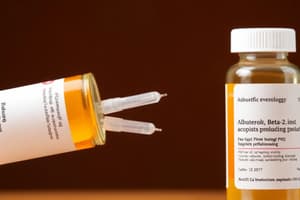Podcast
Questions and Answers
What is the primary function of long-acting beta2-agonists in asthma management?
What is the primary function of long-acting beta2-agonists in asthma management?
- Relieve bronchospasm in acute situations.
- Act as a rescue medication during an asthma attack.
- Provide maintenance therapy to reduce attack frequency. (correct)
- Increase bronchial responsiveness to allergens.
Which side effects are associated with the use of ezetimibe?
Which side effects are associated with the use of ezetimibe?
- Sedation and fatigue.
- Weight gain and hypertension.
- Myopathy and pancreatitis. (correct)
- Nausea and vomiting.
In what way should nitroglycerin transdermal patches be applied for safety and effectiveness?
In what way should nitroglycerin transdermal patches be applied for safety and effectiveness?
- On a hairless area of the body and replaced every week.
- On a hairless area and rotated to a different site every few days. (correct)
- On areas with hair and changed daily.
- On any skin area and left in place as long as needed.
What is a significant advantage of inhaled glucocorticoids over other forms of medication?
What is a significant advantage of inhaled glucocorticoids over other forms of medication?
What potential risk is associated with the use of glucocorticoids in long-term therapy?
What potential risk is associated with the use of glucocorticoids in long-term therapy?
Which medication requires monitoring via PT and INR instead of aPTT?
Which medication requires monitoring via PT and INR instead of aPTT?
What adverse effect is associated with the administration of epinephrine?
What adverse effect is associated with the administration of epinephrine?
Which medication is primarily used as a prophylactic treatment for asthma?
Which medication is primarily used as a prophylactic treatment for asthma?
Which medication should not be given to a client with a heart rate of less than 60 bpm?
Which medication should not be given to a client with a heart rate of less than 60 bpm?
What is the common adverse effect of tiotropium?
What is the common adverse effect of tiotropium?
What is the mechanism of action for clopidogrel?
What is the mechanism of action for clopidogrel?
Which medication is indicated for an acute asthma attack?
Which medication is indicated for an acute asthma attack?
What effect does vitamin K have on warfarin therapy?
What effect does vitamin K have on warfarin therapy?
Study Notes
Short-Acting Beta2-Agonists
- Used to relieve bronchospasm.
- Classified as a rescue medication, meaning it is taken as needed.
- Use should be limited to no more than twice per week.
- If used more than twice per week, should be used with an inhaled glucocorticoid to prevent adverse effects.
Long-Acting Beta2-Agonists
- Used for maintenance therapy to reduce the frequency of asthma attacks.
- Should be used with an inhaled glucocorticoid.
Inhaled Glucocorticoids
- Easy to administer and deliver medication directly to the lungs.
- Mild systemic effects.
- Effective for long-term use in treating and managing asthma.
- Can be used in combination with other medications.
First-Generation Antihistamines
- May induce sedation.
Second-Generation Antihistamines
- Have low lipid solubility, meaning they do not easily cross the blood-brain barrier.
- Do not cause sedation.
Ezetimibe
- Used in the management of hyperlipidemia.
- Inhibits the absorption of cholesterol in the intestinal tract.
- Can have adverse effects like myopathy, hepatitis, pancreatitis, and thrombocytopenia
Glucocorticoids
- Potential side effects include bone growth inhibition, weight gain, hypertension, restlessness, agitation, and irritability.
- Used to treat a variety of conditions including inflammation and severe asthma.
Nitroglycerin
- Used to treat angina.
- Relaxes and prevents spasms in the coronary arteries.
- Decreases the oxygen demand of the heart.
- Transdermal patches should be placed in a hairless area of the body and rotated every few days to avoid skin irritation.
Furosemide
- A high-ceiling loop diuretic commonly used for heart failure.
- Depletes potassium, sodium, chloride, magnesium, and water.
- It is crucial to consume foods high in potassium to prevent hypokalemia (low potassium levels).
Diltiazem
- Calcium channel blocker used to manage atrial fibrillation.
- Contraindicated in clients with hypotension.
- Blocks calcium channels in the heart and blood vessels, lowering blood pressure.
Heparin
- Anticoagulant medication typically administered via intravenous pump.
Cromolyn Sodium
- A mast cell inhibitor used for prophylactic treatment of asthma. - Should be rinsed out of the mouth after use to prevent oral candidiasis (yeast infection).
Methylprednisolone
- An oral corticosteroid effective in the long-term treatment and management of asthma.
Omalizumab
- A medication that reduces the number of IgE molecules on mast cells, helping to prevent the release of histamine and other inflammatory mediators.
- Used in severe asthma cases where other treatments have been ineffective.
Warfarin
- A blood thinner used to prevent blood clots.
- Clients should avoid aspirin and ibuprofen due to their antiplatelet effects, as this could increase the risk of bleeding.
- The International Normalized Ratio (INR) is used to monitor the effectiveness of warfarin therapy, usually drawn at the start of therapy and then regularly for the first few weeks.
- Vitamin K can decrease the anticoagulant effects of warfarin.
Alteplase
- Used to treat myocardial infarction (heart attack), dissolving blood clots that are blocking the coronary arteries.
- Bleeding is a potential adverse effect.
Epinephrine
- The first-line treatment for anaphylaxis.
- Common adverse effects include hypertension, tachycardia (rapid heart rate), and dysrhythmias (irregular heartbeats).
Tiotropium
- Long-acting inhaled medication used to treat chronic obstructive pulmonary disease (COPD).
- A common adverse effect is dry mouth.
Clopidogrel
- An antiplatelet medication that inhibits platelet aggregation.
- It is important to monitor clients for recent myocardial infarction history.
Aspirin
- Suppresses platelet aggregation, making it a critical medication for preventing blood clots.
- Used for immediate antithrombotic effect.
Albuterol
- Short-acting beta-2 adrenergic agonist used to manage acute asthma attacks.
Fludrocortisone
- Maintains electrolyte and fluid balance in clients with Addison's disease.
Sodium Phosphate
- Can cause electrolyte imbalance due to excessive fluid loss.
Digoxin
- Used to treat heart failure.
- Contraindicated in clients with a heart rate less than 60 bpm.
- May cause nausea, vomiting, fatigue, and visual disturbances in some clients.
- Monitor heart rate and potassium levels during digoxin therapy.
Studying That Suits You
Use AI to generate personalized quizzes and flashcards to suit your learning preferences.
Related Documents
Description
Test your knowledge on the pharmacological treatments for asthma and allergies. This quiz covers short-acting and long-acting beta2-agonists, inhaled glucocorticoids, and antihistamines. Understand their uses, classifications, and combinations for effective management.




